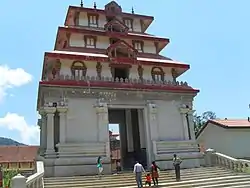Bhagamandala
Bhagamandala is a pilgrimage place in Kodagu district of the Indian state of Karnataka.



Bhagamandala | |
|---|---|
Village | |
 Bhagandeshwara Temple | |
| Coordinates: 12.4196500°N 75.5218300°E | |
| Country | |
| State | Karnataka |
| District | Kodagu |
| Elevation | 898 m (2,946 ft) |
| Languages | |
| • Official | Kannada |
| • Other | Arebhase,Kodava |
| Time zone | UTC+5:30 (IST) |
| PIN | 571 247 |
| Telephone code | 08272 |
| Vehicle registration | KA-12 |
Location
Bhagamandala is situated on the river Kaveri in its upstream stretches. At this place, the Kaveri is joined by two tributaries, the Kannike and the mythical Sujyothi river. It is considered sacred as a river confluence (kudala or triveni sangama, in Kannada and Sanskrit respectively). Bhagamandala is located 133 km south-east of Mangalore. It has an average elevation of 898 m (2,946 ft).[1]
Pilgrim center – Bhagandeshwara Temple
It is a common practice for pilgrims to take a dip in the triveni sangama and perform rituals to their ancestors before proceeding to Talakaveri, the birthplace of Kaveri. A temple of Lord Supremo Shiva in the name of Bhagandeshwara embellishes the place. It is the local belief that Kaveri, revered as Dakshina Ganga, comes out of the matted hair locks of Shiva here. During Tula Sankramana which falls on 17 or 18 October, pilgrims assemble here in large numbers.
Three river meet
A short distance from the triveni sangama, there is a famous temple known as Sri Bhagandeshwara Temple, where murti (sacred images) of Bhagandeshwara (Ishwara), Subramanya and Ganapati are installed. This place is also known as Bhagandeshwara Kshetra, from which the name Bhagamandala is derived. The temples in this area are built in Karavali (West Coast) style.
History
During 1785–1790, the area was occupied by Tipu Sultan. The temple was burnt and destroyed. He renamed Bhagamandala to Afesalabad. In 1790 King Dodda Vira Rajendra took Bhagamandala back into an independent Kodagu kingdom.
Bhagamandala is located about 33 km from the district headquarters Madikeri and is connected by paved roads from Madikeri, Virajpet and nearby places in Karnataka and Kerala. Government and private buses are available on all of these routes.
Padi temple
A short distance from Bhagamandala is the temple at Padi, which houses the deity Lord Igguthapp and is considered by many Arebhase people to be the most sacred shrine in their homeland.
Aiyangeri temple
There is one more temple at Aiyangeri, named "Chinnathappa", which houses the deity Lord Sri Krishna, considered by the people of the village to be the most sacred shrine in their home land. There is a festival once a year in the month of February or March, where the "Golden Flute" will be brought out from the temple.
Mount Thavoor

Mt. Thavoor is a peak overlooking Bhagamandala and Mt. Koppatti, which may be considered its twin peak is nearby and both these serve as trekking routes for the Shola forest range.
Climate
Bhagamandala experiences a Tropical monsoon climate under the Köppen climate classification.
| Climate data for Bhagamandala | |||||||||||||
|---|---|---|---|---|---|---|---|---|---|---|---|---|---|
| Month | Jan | Feb | Mar | Apr | May | Jun | Jul | Aug | Sep | Oct | Nov | Dec | Year |
| Average high °C (°F) | 26.5 (79.7) |
28.1 (82.6) |
29.6 (85.3) |
29.2 (84.6) |
27.9 (82.2) |
23.9 (75.0) |
22.4 (72.3) |
22.8 (73.0) |
23.9 (75.0) |
25.5 (77.9) |
25.6 (78.1) |
25.8 (78.4) |
25.9 (78.7) |
| Average low °C (°F) | 16.0 (60.8) |
17.0 (62.6) |
18.5 (65.3) |
19.7 (67.5) |
20.0 (68.0) |
18.9 (66.0) |
18.6 (65.5) |
18.6 (65.5) |
18.4 (65.1) |
18.6 (65.5) |
17.8 (64.0) |
16.4 (61.5) |
18.2 (64.8) |
| Average rainfall mm (inches) | 5 (0.2) |
5 (0.2) |
20 (0.8) |
115 (4.5) |
232 (9.1) |
1,222 (48.1) |
2,024 (79.7) |
1,222 (48.1) |
479 (18.9) |
318 (12.5) |
101 (4.0) |
24 (0.9) |
5,767 (227) |
| Source 1: Directorate of Economics and Statistics, Karnataka[2] | |||||||||||||
| Source 2: Climate-Data.org[3] | |||||||||||||
References
- "Elevation of Bhagamandala". Archived from the original on 21 May 2019. Retrieved 15 October 2017.
- "DES" (PDF). DES. Retrieved 7 July 2016.
- "CLIMATE: BHAGAMANDALA". Retrieved 18 February 2016.
| Wikimedia Commons has media related to Bhagamandala. |